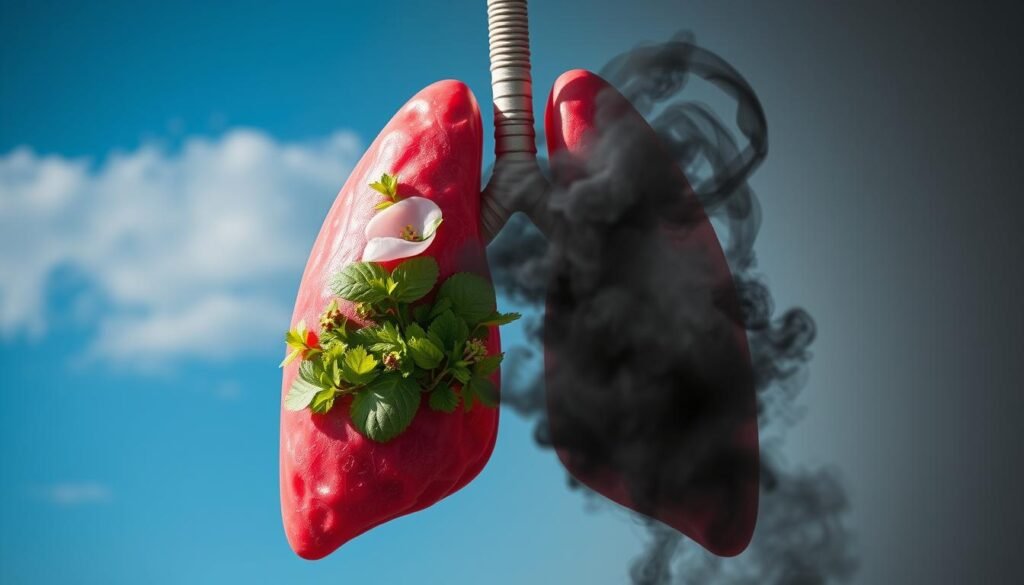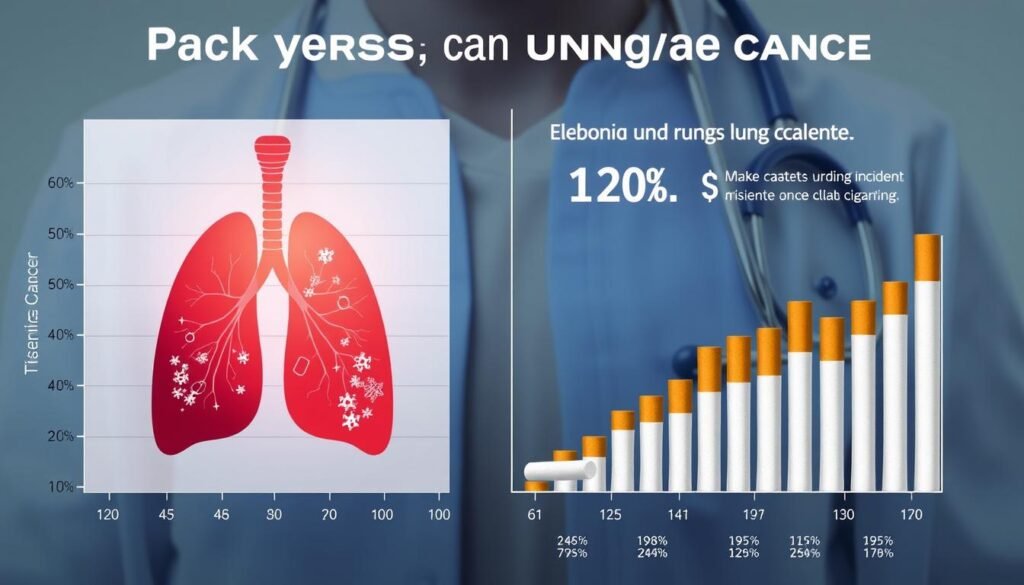Did you know smoking is behind about 1.69 million deaths every year across the world? This is because of lung cancer. It’s a huge number that shows how serious tobacco use is. In the United States, 87% of deaths from lung cancer come from smoking cigarettes. It’s important to understand pack years. They help us see the risk of smoking and its big role in lung cancer rates.
Pack years are key in figuring out the health risks from smoking. They show how many packs someone smokes every day and for how many years. The more pack years someone has, the higher their risk of cancer. This fact makes it clear why we need to stop smoking. And why we need health programs to help lower cigarette use. This piece will look more into how pack years and lung cancer are connected. It will show what this means for smokers and why lung cancer screening is key.
Key Takeaways
- Smoking causes 1.69 million lung cancer deaths annually worldwide.
- 87% of lung cancer deaths in the U.S. are linked to cigarette smoking.
- Pack years quantify smoking duration and are crucial for assessing risk.
- Higher pack year counts are associated with increased lung cancer risk.
- Effective tobacco cessation can significantly decrease lung cancer mortality risk.
- Lung cancer screenings can lower the likelihood of dying from the disease.
Understanding Pack Years
Pack years play a key role in examining smoking’s health impacts, such as lung cancer risk. It’s a combined metric that measures smoking history. It does so by multiplying the daily smoked packs by the years a person has smoked. Health experts use this to evaluate risks related to smoking.
Definition of Pack Years
Understanding pack years is straightforward but important. Take someone who smokes a pack a day for 20 years. They have a 20 pack-years total (1 pack/day x 20 years). This helps show smoking patterns and links with lung cancer or COPD risks.
How Pack Years are Calculated
To calculate pack years, we look at daily smoking amounts. You divide the cigarettes smoked daily by 20, the number in a pack. Knowing the total smoking years and daily packs smoked is crucial. This info helps pinpoint risks for diseases from smoking.
Significance of Pack Years in Smoking Research
In research, pack years matter more than just as a number. Early studies, like those by Doll and Hill in the 1950s, found that most lung cancer patients smoked for over 20 years. The concept became widely used after being mentioned in the 1971 U.S. Surgeon General’s report. It’s been key in understanding that longer smoking periods usually mean higher cancer risks.
Knowing about pack years helps guide public health efforts and screening rules. People between 50 and 80 with at least 20 pack years of smoking are advised to get yearly low-dose CT scans. This links closely with catching lung cancer early. For full details, check the guidelines.
Smoking and Its Relation to Lung Cancer
Lung cancer is a major health issue across the globe, largely due to smoking. Knowing the facts about lung cancer and smoking gives a clearer understanding. In the U.S., smoking is linked to about 87% of lung cancer deaths. Each year, 1.69 million people die globally from lung cancer caused by smoking.
Statistics on Lung Cancer and Smoking
Many studies show a strong link between smoking and lung cancer. Here are some findings:
- Cigarette smoking causes 80% to 90% of lung cancer cases.
- Smokers are 15-30 times more likely to get lung cancer than non-smokers.
- The chance of getting lung cancer is 14.8% for male smokers and about 11.2% for female smokers.
- About 15% of smokers will get lung cancer.
- Non-smokers can also get lung cancer, with up to 20% of cases in this group.
Mechanisms of Cigarette-Induced Carcinogenesis
Smoking leads to cancer through complex ways. Chemicals in cigarettes, like formaldehyde, arsenic, and benzene, damage DNA, weaken the immune system, and cause chronic inflammation. This helps cancer grow. The more you smoke, the higher your risk of lung cancer, showing the dose-dependency of this risk.
Genetics also play a role in lung cancer risk. Studies show a link between the amount smoked, genetic risk, and lung cancer. The risk changes based on genetic factors. It’s vital to understand these processes to fight lung cancer better, both in prevention and treatment.
How Pack Years Correlate with Lung Cancer Incidence
The study of pack years and lung cancer risk is key in cancer research. Many studies show pack years greatly affect lung cancer chances. This knowledge helps find those at high risk and pushes for prevention.
Link Between Pack Years and Increased Cancer Risk
Studies find a strong link between pack years and lung cancer. Specifically, having centrilobular emphysema (CLE) is a sign of higher risk. This points to the role of smoking amount and time in lung cancer risk. Also, more pack years usually mean worse emphysema, raising cancer risk.
Research Findings on Pack Years and Lung Cancer Risk
Recent findings show CLE’s strong connection with age and pack years smoked. Analysis shows pack years, age, and CLE’s severity are key in predicting lung cancer. This information could guide screening and help smokers quit. Smoking cessation programs play a crucial role for those wanting to lower their risk.
The Role of Smoking Duration
Understanding smoking duration is key to knowing lung cancer risks. Research shows that how long you smoke matters more than how much you smoke daily. Longer smoking times are closely linked to higher cancer risks.
This is especially true for those with Chronic Obstructive Pulmonary Disease (COPD). It says a lot about how harmful long-term smoking is.
Impact of Duration on Cancer Development
A study with 10,187 people found a clear link. Those who smoked longer faced more lung damage than those who smoked more per day. This proves that long-term smoking increases cancer risk significantly.
Doctors need to focus on smoking duration when looking at cancer risks. This is vital for those who have smoked for many years.
Comparing Duration to Intensity in Cancer Risk Assessment
Smoking a lot each day does affect health. But, how long you have smoked has a bigger impact on cancer risk, studies show. Even if you smoke fewer cigarettes, smoking for years is more harmful.
For people with COPD, finding the problem early is key to staying healthier. Knowing how smoking over time hurts your health matters. Recognizing symptoms early can help get the right advice quickly.

Cigarette Consumption Patterns
The way people smoke cigarettes has changed a lot over the years. These changes have been driven by different factors. Social norms, laws, and health campaigns have all played a part. While some have cut down on smoking, others still smoke a lot. This affects the health of many people.
Trends in Cigarette Consumption Over the Years
Cigarette smoking habits have shifted over time. Today’s smokers have higher rates of lung cancer compared to non-smokers. For example, smokers have a rate of 1.97 lung cancers per 1000 people each year. Those who’ve quit smoking show fewer lung cancers, at a rate of 1.61. People who never smoked have the lowest rate, at just 0.26. These numbers show that smoking increases cancer risk.
Influence of Consumption Patterns on Health Risks
The health effects of smoking are significant. People who smoked a lot in the past still face a high risk of lung cancer. If someone quit smoking less than five years ago, their risk is still very high. In fact, about 40.8% of lung cancers in those who’ve quit are found more than 15 years later. These facts highlight the lasting impact of smoking. They show why it’s important to keep encouraging people to stop smoking.
Epidemiological Studies on Lung Cancer
Epidemiological studies shed light on how smoking relates to lung cancer. They show how smoking, wealth levels, and environment affect lung cancer rates. By looking at particular groups, scientists find clear connections between smoking and cancer risk.
Notable Studies and Their Findings
The Framingham Heart Study plays a big role in understanding smoking’s long-term dangers. It and similar studies show important trends, especially in advanced countries. They show the big differences in lung cancer rates among races and ethnicities. In Japan, men have high rates of lung cancer. In contrast, women in wealthy countries face higher death rates. Poorer countries have varied patterns, depending on smoking habits and healthcare quality.
Methodologies Used in Lung Cancer Research
Lung cancer research uses many methods, including long-term tracking and updating smoking statuses. These techniques help get detailed data on smoking amounts and lung cancer rates. They also show differences in cancer data reliability between countries. For more information, you can read global research findings on this topic here.

Public Health Awareness and Prevention
Public health awareness is key in fighting lung cancer. It largely involves teaching about the dangers of smoking. Knowing the risks helps people, both smokers and those considering it, make better choices. This effort can lead to fewer cases of lung cancer in communities.
The Importance of Educating Smokers
Educating smokers on the dangers of smoking is vital. It’s particularly important to discuss the concept of pack years. About 17.5% of older U.S. adults said they smoked in the past year. This shows the urgent need for education programs aimed at them.
Bisexual people and other vulnerable groups tend to smoke more. They may not fully understand how smoking affects their health. For example, 50% of LGB adults smoke, a rate higher than among heterosexuals. This highlights the need for public health campaigns that cater to different groups.
Preventive Measures to Reduce Lung Cancer Risk
Stopping smoking before it starts is crucial to lower lung cancer risks. Low-dose CT scans for screening can reduce lung cancer deaths by about 20%. But, only 18% of those who should get screened do so. More awareness can encourage people to participate in these lifesaving screenings.
Adding patient navigators to screening programs can help more people follow through. This makes it easier for individuals, especially heavy smokers, to get screened and possibly save their lives.
Tobacco Cessation Strategies
Stopping tobacco use is key to lowering lung cancer risk and boosting health. Many methods can help people stop smoking, bringing major health benefits. Using behavioral therapy, medication, and joining support groups are effective ways to quit.
Effective Methods to Quit Smoking
There are several good ways to stop smoking:
- Behavioral Therapy: Counseling helps find triggers and make coping plans.
- Medications: Nicotine replacements (like patches, gum) and meds ease withdrawal feelings.
- Support Groups: Being with others who understand can inspire and keep you on track.
Tobacco cessation methods work well in different situations. They offer custom solutions for everyone. Sticking with a plan to stop smoking reduces disease risks linked to smoking.
The Impact of Cessation on Lung Cancer Risk
Quitting smoking greatly reduces lung cancer risk. Studies show that stopping smoking cuts lung cancer risk a lot. In five years, lung cancer rates in ex-smokers drop sharply. This shows the fast benefits of quitting tobacco.
But, continuing to smoke harms health a lot. It speeds up tumor growth and lowers the success of treatments. This highlights the importance of quitting smoking. For more details on quitting smoking and its effects, read this review.

Long-Term Effects of Smoking on Health
Long-term smoking effects last even after you stop smoking. Those who quit smoking still face health risks. It’s important to know these challenges to improve life quality after quitting.
Health Risks for Former Smokers
Even after stopping, former smokers face disease risks, like lung cancer. They’re less likely to get lung cancer than current smokers but more so than non-smokers. So, ongoing health checks are vital.
Understanding the Risk After Quitting
Risks for ex-smokers remain high for years. Heavy smokers face a high risk of lung cancer within five years of quitting. But this risk lowers over 25 years.
Over 40% of lung cancers in former smokers are found 15 years after they quit. This shows why it’s essential to keep up with health screenings long-term. Staying vigilant helps manage health risks for those who’ve quit.
Conclusion
The link between pack years and lung cancer risk is important. It shows that lung cancer is still a big problem despite fewer people smoking. Knowing how long and how much people have smoked helps us create better public health plans.
Quitting smoking greatly reduces lung cancer risk. Yet, risks can linger after quitting. This shows why it’s crucial to keep pushing for strong stop-smoking programs. These programs give people the help they need to quit for good.
We need to keep spreading the word about the dangers of smoking. If we do, we can lower the number of people who get lung cancer. Research and public health efforts must continue to help everyone stay healthier.